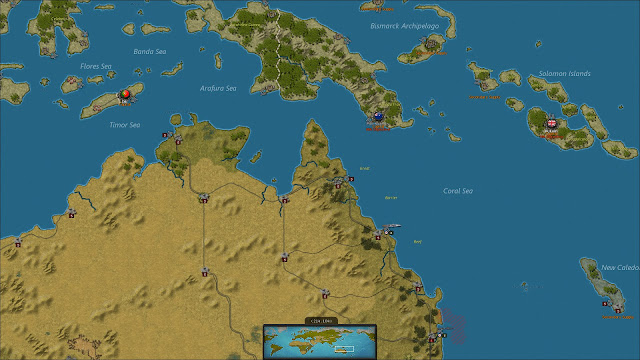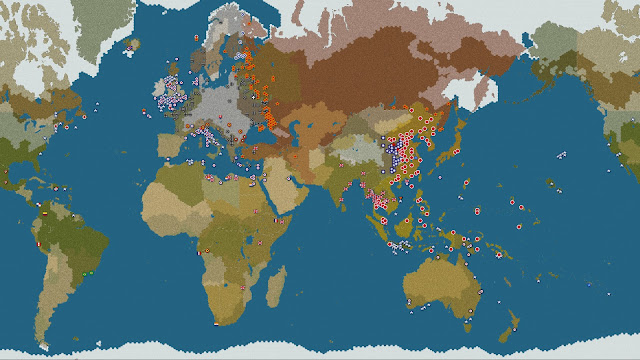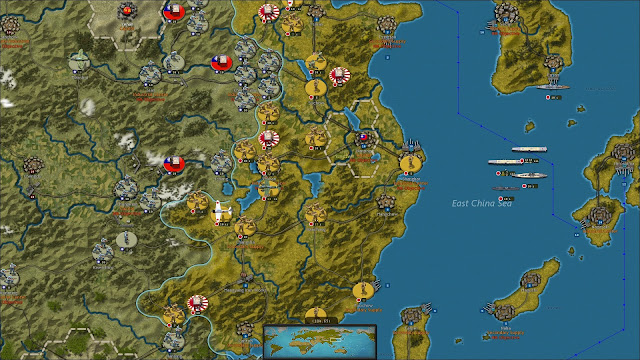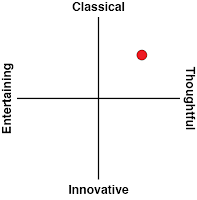Review by Matt S.
I’m constantly criticising the way that stuff like Battlefield and Call of Duty handle World War 2. It’s not that I think World War 2 should not be the subject of video games, film, or anything else. It’s that I think there should be a moral obligation on treating the subject of war with respect and maintaining a genuine effort at historical accuracy. This “heroes and baddies” nonsense that we see through almost every popular game and blockbuster film are irresponsible to the point of being dangerous. That’s my issue with these games.
Strategic Command WWII is the right kind of game based on World War 2. A grand strategy game that encompasses the entire scope of the war, it comes across as dry and, well, hardcore, but in terms of understanding the diplomatic environment and the military tactics of the war, Strategic Command is enlightening and fundamentally interesting.
Authenticity is absolutely critical to a game like this, and Strategic Command has clearly been designed by students of the historical period. You’ve got a couple of different options on which date to start a campaign – either right at the outbreak of World War 2, or at a couple of key turning points of the conflict each time. Regardless of which point you start, each nation has its military strength and units abstracted down to a number of “tiles”, and placed around the map based on where they would have been at that point in the actual conflict.
Naturally this means that Strategic Command isn’t all that balanced. If you start the game in 1939, just as Germany starts rolling into Poland, the Axis has the overwhelming advantage. America’s still not involved, Japan has access to the resources of Manchuria, and Germany has one hell of strong land army. It is almost impossible for the Allies to defend Poland in this scenario, but, of course, World War 2 was a long conflict, and if you choose to play as the Allies, you need to instead find a way to stem the tide, and then start to push it back. Start a game in the later half of World War 2, and it becomes almost impossible to hold out as the Axis.
Beyond the initial placement of soldiers and the initial diplomatic status of each nation, once the game starts in full it’s entirely possible that the conflict will play out differently to what it did in real life. The Japanese might antagonise America into the war too early. Or, alternatively, they might roll over Asia and consolidate an insurmountable position first. The Germans might deal with the English navy better. Or Poland may just hold out from the initial drive. The whole purpose of the game is to see if you can change history, or at least understand why history played out the way it did, and in playing Strategic Command you do come to understand why America pressured Japan into attacking it, or why Hitler made the fatal decision to march on Moscow. The game does a brilliant job of making you feel the same strategic stresses.
In theory combat itself plays out a little like something like Advance Wars; two sides have a respective number of “health points,” and factors such as the quality of the unit, and how well defended it is, will affect how much damage units do to one another. Aerial units can conduct bombing runs, artillery can strike from a distance, and so on and so forth. Strategic Command has a whole host of other, much more strategic considerations, however, including supply, morale, and the reinforcements require much more strategy too. “Buying” a unit from the resources generated each turn doesn’t mean you can immediately place them on the map – you need to allow time for the unit to be produced. And so, just like in the real war, it’s important to be thinking months of in-game time down the track so that you’re not left under-powered at a decisive moment.
Strategic Command doesn’t come across as the most accessible experience, though in truth it takes less time to learn and understand than you’ll initially think. The interface is a little clunky, and the art is messy, though thankfully if you’re not a fan of the little “tiles” visual look that grognards love (but no one else does), you can turn on a “3D” picture to visually represent each unit in a more natural, clearly representational manner. Once you figure your way around the menus and interface, the only other real challenge is dealing with how slow-paced the game is. Because you’re taking an entire side of the conflict, a single turn can take a long time to actually finish, and if you fail to pay attention to any corner of the conflict, the AI will inevitably take advantage of your inaction. Coming right off Civilization VI, itself a complex game but built around each turn taking up a limited amount of time, it took me some real adjusting to resist racing through turns.
Strategic Command’s greatest strength is the AI, without a doubt. Compared with a lesser strategic take on World War 2 (for example, World Conqueror X), Strategic Command’s units know how to hold a line, make clever probes into opponent’s territory, and not needlessly throw resources away. It’s not a patch on playing against a human opponent, of course, but it’s more than enough to provide a rich strategic challenge.
For anyone with an interest in military strategy, Strategic Command WWII is a solid look at the most horrific, and yet strategically rich, war that history has ever seen. It’s a dry, almost textbook look at the war and movement of forces around the battlefield, and there’s no mention of the horrors that happened away from the battlefields through the conflict. The result is that the game has a more academic tone, and thus it’s a useful tool for people that want to learn more about the war without the deep emotions that it tends to evoke.
Strategic Command WWII: World At War doesn’t come across as overly accessible to any but the most hardcore strategy game fan, but that’s just the surface of it. Underneath that is a genuinely good effort to capture the many diplomatic and strategic complexities of World War 2, and coupled with quality AI, this is a game that offers armchair generals a lot.
– Matt S.
Editor-in-Chief
Find me on Twitter: @digitallydownld
Please help keep DDNet running: Running an online publication isn’t cheap, and it’s highly time consuming. Please help me keep the site running and providing interviews, reviews, and features like this by supporting me on Patreon. Even $1/ month would be a hugely appreciated vote of confidence in the kind of work we’re doing. Please click here to be taken to my Patreon, and thank you for reading and your support!











